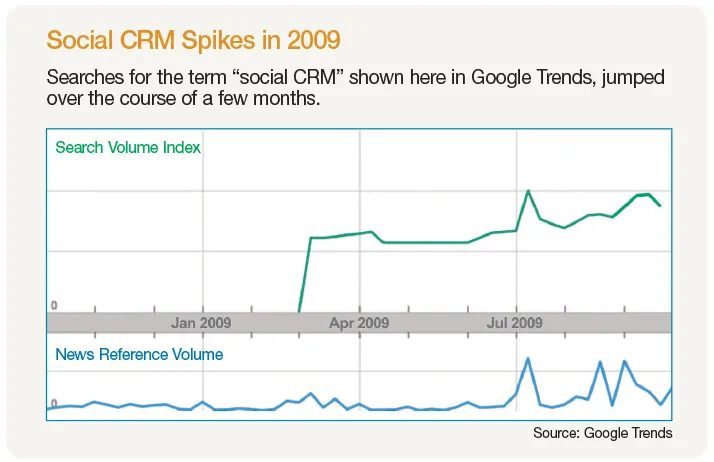Many corporate executives are still puzzling over Social CRM—what it is and why it’s important. So, let me clarify it with a definition:
“Social CRM is a philosophy and a business strategy, supported by a technology platform, business rules, workflow, processes, and social characteristics, designed to engage the customer in a collaborative conversation in order to provide mutually beneficial value in a trusted and transparent business environment. It’s the company’s response to the customer’s ownership of the conversation.”
Social CRM is important to business, but there is something else that must be understood: Social CRM is a science of business. The reason it exists is because of a revolution that doesn’t stem from business, but instead is in how we communicate—a social revolution that affected every single institution that we deal with—economic, social, political, and business, among others. We saw its most dramatic manifestation in the election of Barack Obama as the U.S. president.
When it comes to business, this communications revolution has given control of the agenda to the customer. They are able, due to a wide array of easy choices for the purchases of similar products and services, to pick and choose who they want to deal with and when they want to deal with them. If they don’t like what they are hearing and seeing, they not only can move to another provider to buy what they need to, but now, through the use of the Web, they have the tools they need to easily correspond with their peers about why they moved to another provider—usually a bad thing for the business they left.
In fact, according to Forrester Research, 74 percent of the people using the Web are tied into one or another social network. Couple that with a Nielsen Global Media report from March 2009 that found that more people using the Web are reached via social networks (about 66 percent) than via email (about 65 percent) and you have the early stages of a perfect storm by the social customer. This means that they are able to not only find what they need from multiple companies, but if you don’t please them as a company, they can voice that displeasure in ways that are magnitudes more damaging than an email or phone conversation. Keep in mind, in 2008 there were also more than 3 billion text messages sent in the U.S. alone.
In other words, most people do use the Web to converse—and the businesses they deal with are just one of the topics of their conversations.
This means that companies need to figure out how they are going to respond to customers’ control of the business ecosystem. If they are progressive thinkers, they’ll concern themselves with strategies to engage their customers, so those customers will feel like coparticipants in the fate of the business—or at least in the fate of the interactions they’re having. For example, Procter & Gamble created social networks for their primary customers; moms and teens have used these social networks to give feedback and to test products. One of them, Vocal Point, a social network of 600,000 moms, has been so successful in testing products that it has become a profit center for the company, with its own CEO. It no longer does product testing only for P&G, but also for products submitted to it (for a fee, of course).

Strategy first
Note that I didn’t talk about the use of Social CRM software here. First and foremost, we are dealing with a customer engagement strategy that has facets of customer management as part of it. But it is focused around how to interact with customers individually—even if you have millions of them—and how to help them resolve the parts of their personal agendas that you are qualified to resolve. Do that and not only do you get purchases from them, but you also get word-of-mouth advocacy.
For companies to achieve effective social CRM, enabling software as well as processes, cultural transformation, locations, activities, and experiences are involved in that Social CRM toolbox.
There are competent Social CRM tools out there to help you in the execution of your engagement strategy. They are available in the pillars of traditional CRM applications: sales, marketing, and customer service. Where they differ from traditional CRM tools is that they not only provide the means to improve process effectiveness, but they also are aimed at capturing feedback from customers and providing channels for customer interaction, like social media monitoring tools and community platforms.
So, what’s next?
Social CRM is a young, refreshing, and mission-critical approach to dealing with the newly empowered social customer. What does this mean for the evolution of Social CRM? What you’ll see over the next few months is a maturation of what is out there. That means that the most successful enterprise technology vendors that are claiming to offer Social CRM tools, while most likely not actually providing the suites that could make that claim legitimate, will be companies providing social technologies that integrate with more traditional CRM systems.
You’ll see competent tools in all areas, including sales, marketing, and customer service. You’ll see some tools in areas that overlap it, like those social media monitoring tools or community platforms. You’ll see more strategies emerging built on an increasing number of success stories with meaningful measurements associated with their results. You’ll see the ability to measure what makes a successful lifetime with a customer move beyond just his financial value to a company over time to his referral value, as influential customers become increasingly important to a company’s thinking when it comes time to figure out what to do. You’ll see the hard work it will take to figure out how to institutionalize effective Social CRM strategies and practices.
In other words, you’ll see the capabilities necessary to deal with the social customer emerge from vendors, thought leaders, consultants, strategists, journalists, and practitioners—all of whom, in their daily lives, are the very same people who are living that communications revolution.
So, hang tough, grasp the basic concept of Social CRM—that you and your customer are in it together to provide mutually derived and individually beneficial value—then go out and look into what you need for the toolbox and get down to it. The social customers you have will be grateful.















